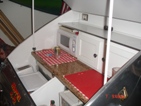Gasoline filling tips from a pipeline pro
16 posts
• Page 1 of 2 • 1, 2
Gasoline filling tips from a pipeline pro
Gasoline filling tips from a pipeline pro
Jonathan Kreusch says......
I've been in petroleum pipeline business for about 31 years, currently working for the Kinder-Morgan Pipeline here in California. We deliver about 4 million gallons in a 24-hour period from the pipe line; one day it's diesel, the next day it's jet fuel and gasoline. We have 34 storage tanks here with a total capacity of 16,800,000 gallons. Here are some tricks to help you get your money's worth:
1. Fill up your car or truck in the morning when the temperature is still cool. Remember that all service stations have their storage tanks buried below ground; and the colder the ground, the denser the gasoline. When it gets warmer gasoline expands, so if you're filling up in the afternoon or in the evening, what should be a gallon is not exactly a gallon. In the petroleum business, the specific gravity and temperature of the fuel (gasoline, diesel, jet fuel, ethanol and other petroleum products) are significant. Every truckload that we load is temperature-compensated so that the indicated gallonage is actually the amount pumped. A one-degree rise in temperature is a big deal for businesses, but service stations don't have temperature compensation at their pumps.
2. If a tanker truck is filling the station's tank at the time you want to buy gas, do not fill up; most likely dirt and sludge in the tank is being stirred up when gas is being delivered, and you might be transferring that dirt from the bottom of their tank into your car's tank.
3. Fill up when your gas tank is half-full (or half-empty), because the more gas you have in your tank the less air there is and gasoline evaporates rapidly, especially when it's warm. (Gasoline storage tanks have an internal floating 'roof' membrane to act as a barrier between the gas and the atmosphere, thereby minimizing evaporation.)
4. If you look at the trigger you'll see that it has three delivery settings: slow, medium and high. When you're filling up do not squeeze the trigger of the nozzle to the high setting. You should be pumping at the slow setting, thereby minimizing vapors created while you are pumping. Hoses at the pump are corrugated; the corrugations act as a return path for vapor recovery from gas that already has been metered. If you are pumping at the high setting, the agitated gasoline contains more vapor, which is being sucked back into the underground tank so you're getting less gas for your money.
Hope this will help ease your 'pain at the pump'.
http://www.snopes.com/inboxer/household/gastips.asp
Jonathan Kreusch says......
I've been in petroleum pipeline business for about 31 years, currently working for the Kinder-Morgan Pipeline here in California. We deliver about 4 million gallons in a 24-hour period from the pipe line; one day it's diesel, the next day it's jet fuel and gasoline. We have 34 storage tanks here with a total capacity of 16,800,000 gallons. Here are some tricks to help you get your money's worth:
1. Fill up your car or truck in the morning when the temperature is still cool. Remember that all service stations have their storage tanks buried below ground; and the colder the ground, the denser the gasoline. When it gets warmer gasoline expands, so if you're filling up in the afternoon or in the evening, what should be a gallon is not exactly a gallon. In the petroleum business, the specific gravity and temperature of the fuel (gasoline, diesel, jet fuel, ethanol and other petroleum products) are significant. Every truckload that we load is temperature-compensated so that the indicated gallonage is actually the amount pumped. A one-degree rise in temperature is a big deal for businesses, but service stations don't have temperature compensation at their pumps.
2. If a tanker truck is filling the station's tank at the time you want to buy gas, do not fill up; most likely dirt and sludge in the tank is being stirred up when gas is being delivered, and you might be transferring that dirt from the bottom of their tank into your car's tank.
3. Fill up when your gas tank is half-full (or half-empty), because the more gas you have in your tank the less air there is and gasoline evaporates rapidly, especially when it's warm. (Gasoline storage tanks have an internal floating 'roof' membrane to act as a barrier between the gas and the atmosphere, thereby minimizing evaporation.)
4. If you look at the trigger you'll see that it has three delivery settings: slow, medium and high. When you're filling up do not squeeze the trigger of the nozzle to the high setting. You should be pumping at the slow setting, thereby minimizing vapors created while you are pumping. Hoses at the pump are corrugated; the corrugations act as a return path for vapor recovery from gas that already has been metered. If you are pumping at the high setting, the agitated gasoline contains more vapor, which is being sucked back into the underground tank so you're getting less gas for your money.
Hope this will help ease your 'pain at the pump'.
http://www.snopes.com/inboxer/household/gastips.asp
Last edited by halfdome, Danny on Mon Oct 29, 2007 12:30 pm, edited 1 time in total.
"Conditions are never just right. People who delay action until all factors are favorable do nothing". William Feather
Don't accept "It's Good Enough" build to the best of your abilities.
Teardroppers Of Oregon & Washington
-

halfdome, Danny - *Happy Camper
- Posts: 5894
- Images: 252
- Joined: Sun Aug 14, 2005 11:02 pm
- Location: Washington , Pew-al-up
Interesting Danny.
I most generally use about 5 gallons for a round trip to work. Almost every day I fill up (at about 6:00am).
The advantage for me is less fillup time each day plus if a big change in gas price happens, it doesn't feel so bad. Plus I can look around a little since I pass about 10 different stations each day.
The "temperature" compensation is something I've thought about often. Our measurement systems are calibrated to temperature each time we use them so that part makes sense.
Thanks for the tips, now I know my filling techniques make some sense.
I most generally use about 5 gallons for a round trip to work. Almost every day I fill up (at about 6:00am).
The advantage for me is less fillup time each day plus if a big change in gas price happens, it doesn't feel so bad. Plus I can look around a little since I pass about 10 different stations each day.
The "temperature" compensation is something I've thought about often. Our measurement systems are calibrated to temperature each time we use them so that part makes sense.
Thanks for the tips, now I know my filling techniques make some sense.

-

Kurt (Indiana) - Donating Member
- Posts: 3538
- Images: 178
- Joined: Mon Jun 27, 2005 8:35 pm
- Location: Marion, Indiana


 Danny
Danny

